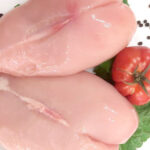
Minced Beef
Real mince consists of very finely chopped meat, not a smooth batter. Too little taste is usually due to a low-fat level – the proportion should be about 15 per cent fat.
HOW TO COOK MINCED BEEF
To have mixed meat in the mince – from different pieces and different animals – produces a richer and deeper taste. The Italians likes to use anchovies to enhance the taste of meatballs and quenelles. Mince of pork and/or cream makes the mince juicier.
The minced meat in hamburgers, meat loaves, etc, should be airy with a fine structure, so do not work the mince too long otherwise it becomes compact and dull when cooked.
Mince that is to be eaten raw is ground from finer pieces. Steak tartare is traditionally made of inner thigh, but flank is also a tasty choice. The meat for steak tartare should be cold when ground, but not on the plate because cold fat is hard and tasteless. Steak tartare should be eaten lukewarm, to enhance the fine taste from the raw material.






































































































































